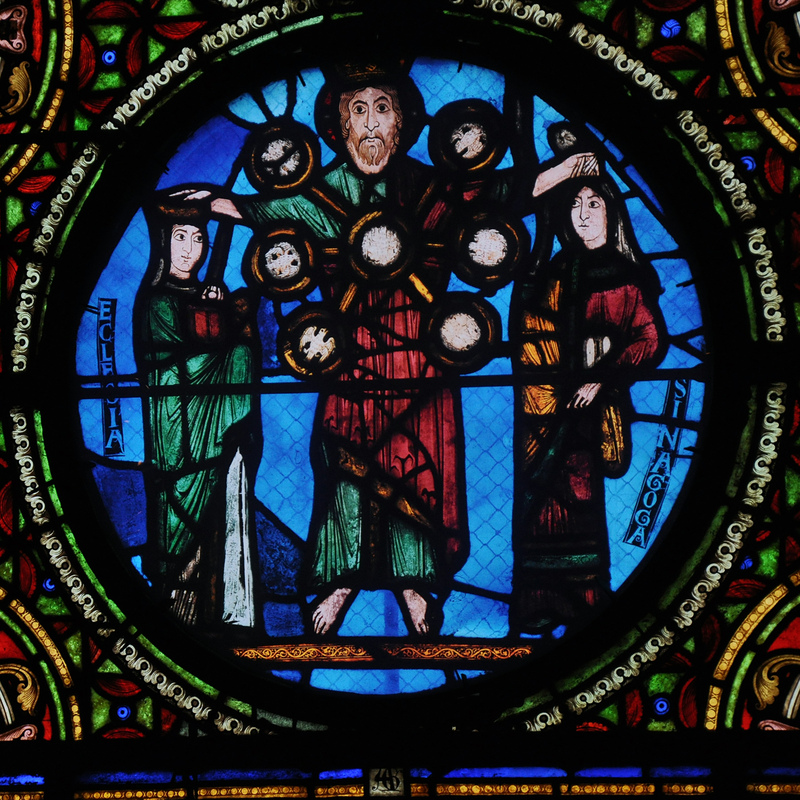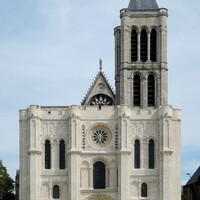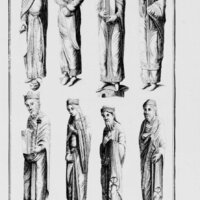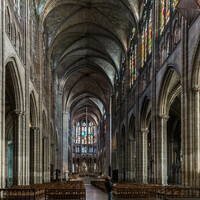Abbey church of Saint-Denis
Type:
Churches,
Sculptures,
Stained-glass windows
Date:
1130s and 40s
Location or Findspot (Modern-Day Country):
France
Description:
The abbey of Saint-Denis, which had fallen into disrepair by the twelfth century, was renewed under the patronage of Abbot Suger (r. 1122–51). Although Suger made many additions and donations to the existing abbey church, maintaining connections to the past was also important to him.
Suger's new west facade of the 1130s had three arched openings, with two smaller ones flanking the larger central openings. The overall arrangement recalled the triumphal arches of antiquity, but the portals also incorporated jamb statues—a new innovation that became a common feature in the church architecture of the period. The sculptures were representations of Old Testament kings, queens, patriarchs, and prophets, who served as behavioral models for the French royalty traditionally buried at Saint-Denis. Although much of the original sculpture of Suger's portal was removed in 1771, the eighteenth-century drawings of Bernard de Montfaucon suggests their original appearance. There are also fragments preserved in museums, including the heads of kings reproduced here from the Walters Art Museum.
In addition to the west facade with three portals, Suger added four bays to the eighth-century nave, a new porch, two towers, and a rose window. The new chevet (elongated U-shaped area behind the main altar to the east), consecrated in 1144, has pointed vaults that support weight more effectively than vaults on round arches. This architectural innovation allowed for stained-glass windows of unprecedented size.
Like the jamb sculptures, most of the stained glass at Saint-Denis is no longer original. The best-preserved twelfth-century windows are the Moses and "anagogical" windows in the Chapel of St. Peregrinus. The former illustrates events from the life of Moses and the latter has images inspired by the Epistles of Saint Paul. The detail shown here is from the anagogical window and includes some twelfth-century glass. It illustrates Christ between Ecclesia and Synagoga, the personifications of the Church and Synagogue. Although Synagoga is often depicted blindfolded (suggesting the Jews' metaphorical blindness), Christ pulls the veil from her eyes.
The Infancy window, in the Chapel of the Virgin, has a well-known portrait of Suger kneeling before the Virgin in a representation of the Annunciation. Although much of the panel has been restored, Suger's face, hands, and name (written above his head) are all original.
Suger is not only associated with changes to the fabric of the church itself but also with donations of precious objects (see the separate entries on the Eleanor Vase and Eagle Vase).
Relevant Primary Sources
Suger's new west facade of the 1130s had three arched openings, with two smaller ones flanking the larger central openings. The overall arrangement recalled the triumphal arches of antiquity, but the portals also incorporated jamb statues—a new innovation that became a common feature in the church architecture of the period. The sculptures were representations of Old Testament kings, queens, patriarchs, and prophets, who served as behavioral models for the French royalty traditionally buried at Saint-Denis. Although much of the original sculpture of Suger's portal was removed in 1771, the eighteenth-century drawings of Bernard de Montfaucon suggests their original appearance. There are also fragments preserved in museums, including the heads of kings reproduced here from the Walters Art Museum.
In addition to the west facade with three portals, Suger added four bays to the eighth-century nave, a new porch, two towers, and a rose window. The new chevet (elongated U-shaped area behind the main altar to the east), consecrated in 1144, has pointed vaults that support weight more effectively than vaults on round arches. This architectural innovation allowed for stained-glass windows of unprecedented size.
Like the jamb sculptures, most of the stained glass at Saint-Denis is no longer original. The best-preserved twelfth-century windows are the Moses and "anagogical" windows in the Chapel of St. Peregrinus. The former illustrates events from the life of Moses and the latter has images inspired by the Epistles of Saint Paul. The detail shown here is from the anagogical window and includes some twelfth-century glass. It illustrates Christ between Ecclesia and Synagoga, the personifications of the Church and Synagogue. Although Synagoga is often depicted blindfolded (suggesting the Jews' metaphorical blindness), Christ pulls the veil from her eyes.
The Infancy window, in the Chapel of the Virgin, has a well-known portrait of Suger kneeling before the Virgin in a representation of the Annunciation. Although much of the panel has been restored, Suger's face, hands, and name (written above his head) are all original.
Suger is not only associated with changes to the fabric of the church itself but also with donations of precious objects (see the separate entries on the Eleanor Vase and Eagle Vase).
Relevant Primary Sources
Relevant Textbook Chapter(s):
7
Repository and Online Resources:
For reconstructions of Saint-Denis during different periods, visit the site's official website.
For the construction history in phases as well as virtual tours of the interior, visit John James's Creation of Gothic website.
For detailed descriptions of the twelfth-century stained glass (including diagrams of which areas are restorations), see the Images of Medieval Art and Architecture website.
Read more about the head of a jamb figure preserved in the Walters Art Museum.
See a painting from around 1500 that shows the now-destroyed Carolingian altarpiece and crux gemmata, both of which Suger describes in his
writings about the church.
Image Credits:
Wikimedia Commons, Walters Art Museum








